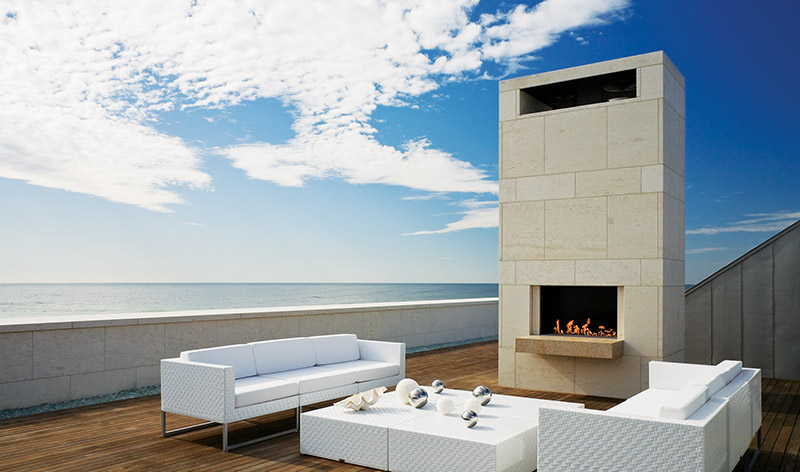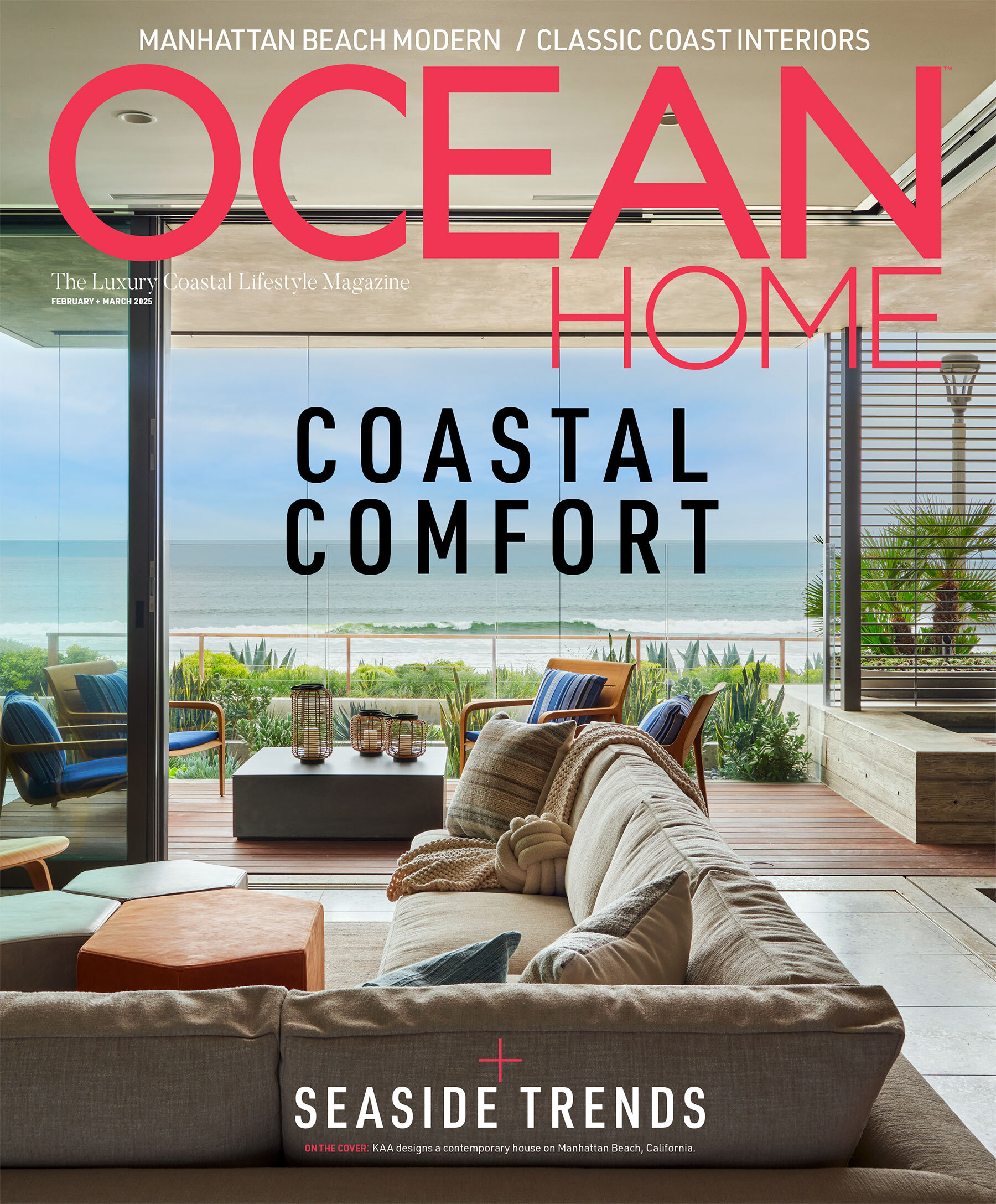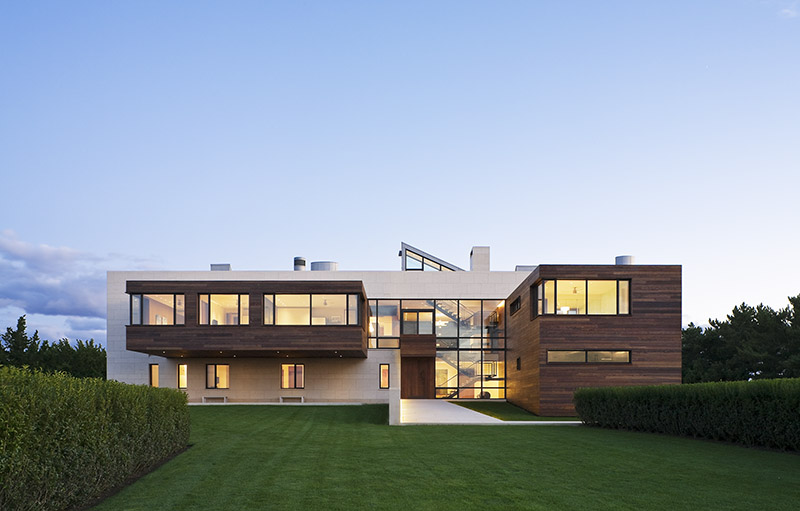It’s a modern riff on a classical theme. In the bucolic setting of the Hamptons, on New York’s Long Island, architect Alexander Gorlin has designed a beach house that invokes Janus – that ancient dual-faced Roman deity – as he deftly responded to a site with panoramic views of both sunrise and sunset.
Janus was the god of beginnings and endings. He was also the symbol of transitions between countryside and city, youth and adulthood. His likeness was often placed above the main entrance of a Roman villa, to face inside and out, symbolically guarding both the interior and exterior lives of its inhabitants.
None of that was lost on Gorlin. This home in the Hamptons not only looks east and west, but works overtime to balance the effect and relationship of light and vistas from each direction. “It’s just a shack on the beach,” the architect shrugs, his tongue planted squarely in cheek as he describes the transparent, 10,000-square-foot home.
But what a shack and what a beach – and moreover, what a bay. Inside and out, Gorlin has opened up this house to all of its surroundings – sky included. Long and low, its architecture looks out to the horizon of the Atlantic Ocean and responds to the sun with shade. On the west elevation, it is cantilevered widely to reach out towards the beautiful Shinnecock Bay.
The site’s three-acre lot is rectangular, its 300-linear-foot eastern edge met by the ocean. The home, perched atop a sand dune, slices through the beachfront property at a right angle for sun-drenched western views of marsh, bay and forest.
 |
“I’m a modernist. I’m interested in the impact of light and space on how people live,” he says. “I’m also interested in how the project relates to the immediate site – the integral relation of house to landscape.”
The landscape here is untouched and primal, with an unusually wide beach on the Atlantic, and the 800-acre Shinnecock Indian Reservation, owned by Algonquin-speaking Native Americans to the west. Their land stands completely undeveloped, as it has for centuries.
As is often the case, poverty preserves – and here, Gorlin has designed this two-story home to take masterful advantage of the untouched natural world. On its western facade, two teak volumes pop out to frame a double-height entrance. A cantilevered volume on the left encloses a sunset porch and two offices for his clients, a New York City couple with two daughters. The cantilevered space also provides a shady spot below for Zumba and yoga classes on Sunday mornings. On the right is a two-story volume with garage below and bedrooms for the two children above.“There’s nothing built there at all,” he adds. “They’re poverty-stricken, and sitting in middle of the Hamptons.”
“Because of restrictions on height related to the dune, it’s an upside-down house – you enter below into the guest room, media room, mud room and garage,” says Gorlin. “So the more public rooms are above –the living and dining rooms, along with the two girls’ rooms, plus the master. And of course, everyone wants to face the ocean.”
That’s possible not only for the family arriving on weekends to escape the city, but also for their guests. The home culminates at its roof terrace, a Le Corbusier-inspired affair with a promenade meant to recall the prow of a ship. Because all parts of the residence are used for entertaining, there’s a constant flow of people through it – inside to out, swimming pool to roof deck.
The deck flooring is laid in Ipe wood – some of the hardest in the world – judiciously editing the views it offers. “It’s a floating canopy, with a shady porch where you can sit out and watch the ocean,” Gorlin says. “You see the terrace and the ocean, but you don’t see the beach.”
This home is all about using stone, glass and wood in a classically modern way. “There’s a bit of Louis Kahn, in terms of making a clear distinction between materials,” Gorlin adds.
On both ocean and bay sides, he employed a frame of Bulgarian limestone, chosen not just for its buff-colored tone that matches the sand of the beach, but because it stands up well to winter’s frost. The home’s stone piers serve as architectural devices that respond to two different conditions on either side. On the eastern facade, the stone is dominant; on the western front, the two volumes flanking the entrance are sheathed in Afromosia, a highly durable African teak that needs little maintenance.
“It tries to be as simple as possible but, quite often, achieving simplicity is very complex,” he says. “All of the structural issues behind the frame and the cantilever are complex.”As is the architect’s practice, Gorlin’s firm does not design for the Hamptons alone – far from it. He chooses to work across a broad range of categories, including schools, synagogues and even the restoration of Eero Saarinen’s massive 1962 Bell Labs in Holmdel Township, N.J.
He’s currently collaborating with artist Pharrell Williams on a line of prefabricated houses, and designing affordable housing for the Bronx-based non-profit, Common Ground. “It’s called supportive housing, with social workers, computer classes, and counseling on how to secure jobs and start life over,” he says.
The variety of his work should come as no surprise. Like his beach house in the Hamptons and the Roman god who inspired it, this is an architect with more than one view of the world. gorlinarchitects.com
Image Credits: Photos by Michael Moran for Otto.



